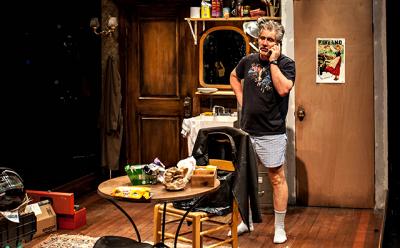‘The Night Alive’: Lost Souls in Dublin

The last time the Irish playwright Conor McPherson had major play across the pond, it was in 2006, with “The Seafarer,” which I had the good luck to see on Broadway. In many ways it is Mr. McPherson’s signature play, including all of his classic elements and concerns: humor, drinking, the Irish character, pipe dreams, the supernatural, and a good amount of blarney. It was largely that play that prompted Ben Brantley of The New York Times to call Mr. McPherson “quite possibly the finest playwright of his generation.”
“The Seafarer” may well go down as Mr. McPherson’s masterpiece, but if you missed that play you now have the opportunity to see one nearly as good with the current production of “The Night Alive‚“ which is running through May 22 at East Hampton’s Guild Hall. “The Night Alive” ran Off Broadway in 2013 and snagged the New York Drama Critics Circle Award, and this fine production gives local audiences a chance to see the work of a world-class playwright performed right in their own backyard.
The setting is a squalid flat in Dublin in “the recent past,” where a disheveled and struggling middle-aged man named Tommy is renting a room from his uncle Maurice. It’s an arrangement of lost souls: Tommy has split from his wife while still trying to be a father to two teenage girls; Maurice, meanwhile, is a drunk whose wife died a few years ago after slipping on the ice, which may well have been his fault. “I didn’t take her arm,” he recalls tragically, because “we were having an argument.” Maurice often comes into Tommy’s room to voice his disapproval of his nephew’s life, but his scorn has its seeds in self-hatred.
Tommy, meanwhile, survives by doing odd jobs with his “business partner,” the slow-witted Doc. The two are managing to skate by, but it is a delicate balance. Money is tight, and Doc seems incapable of surviving without Tommy (there are echoes of “Of Mice and Men” in the relationship).
Then, one night, Tommy brings home a prostitute, who has been beaten up by her boyfriend. This is the play’s opening sequence, where Tommy, played by Kevin O’Rourke, lovingly attends to the bloodied prostitute, Aimee. It is a scene meant to introduce us to Tommy’s humanity, which only becomes more apparent as the drama unfolds — he is a man beaten up by life, but one who has not yet lost his inherent decency.
It’s one thing to write a character like this and quite another to play him, but Mr. O’Rourke, in an outstanding performance, manages to find just the right balance of charm and quiet despair. He is an immensely likeable actor, and although Tommy has made a mess of things in his life, you find yourself rooting for him beyond even what the playwright is asking for.
The actors are solid all-around, especially J. Stephen Brantley, who brings a touch of Art Carney to the role of Doc. This may be the one stock character in the play: the mentally challenged sidekick with a fine-tuned sense of humor and a special instinct for the heart. It’s not easy to drag these elements out of the realm of cliché, but Mr. Brantley gives Doc a quirky energy and offbeat optimism that makes his mistreatment in the play all the more affecting.
This mistreatment comes at the hands of Aimee’s boyfriend, Kenneth, who, the play suggests, may be an incarnation of the devil, or at least a literary cousin of one of Bret Easton Ellis’s handsome sociopathic yuppies. As played by Rob DiSario, with his threateningly angled eyebrows and tailored suit, he is genuinely menacing, and when the violence comes Mr. DiSario carries it off with a relish that had the audience wincing.
As with other recent productions, Guild Hall allows the audience on the stage for “The Night Alive,” mere inches away from the actors. Sounds great, doesn’t it? Actually, it’s a mixed blessing. On the one hand, there is the visceral thrill of being so close to the action, while at the same time you can be visually distracted when the onlookers are so close you wonder if they’re going to rest their feet on Tommy’s cot. With no buffer between the audience and the stage it can be an intrusion on one’s visual space and concentration.
The set, however, is impeccable, with its shabby crates, worn posters, and wood paneling. And the soundtrack, which ranges from Radiohead to Vic Chestnut to Marvin Gaye, feels exactly right — and may even provide a few overlooked gems to add to your iTunes.
Finally, there’s nothing wrong with Molly Carden’s performance as Aimee; her character has been ill-usedby the world, and Ms. Carden rightly plays her as wary-eyed and suspicious. This limits, however, what the character (and actress) can deliver. It also counts “The Night Alive” as another Conor McPherson play that lacks a memorable female. While his plays teem with rich male characters, he has yet to write his Mary Tyrone or Blanche Dubois.
He’ll need to, eventually, if he is to enter the door of greatness at which he is clearly knocking. In the meantime, we have the still-captivating “The Night Alive,” with an intense and rousing production happening close to home.
